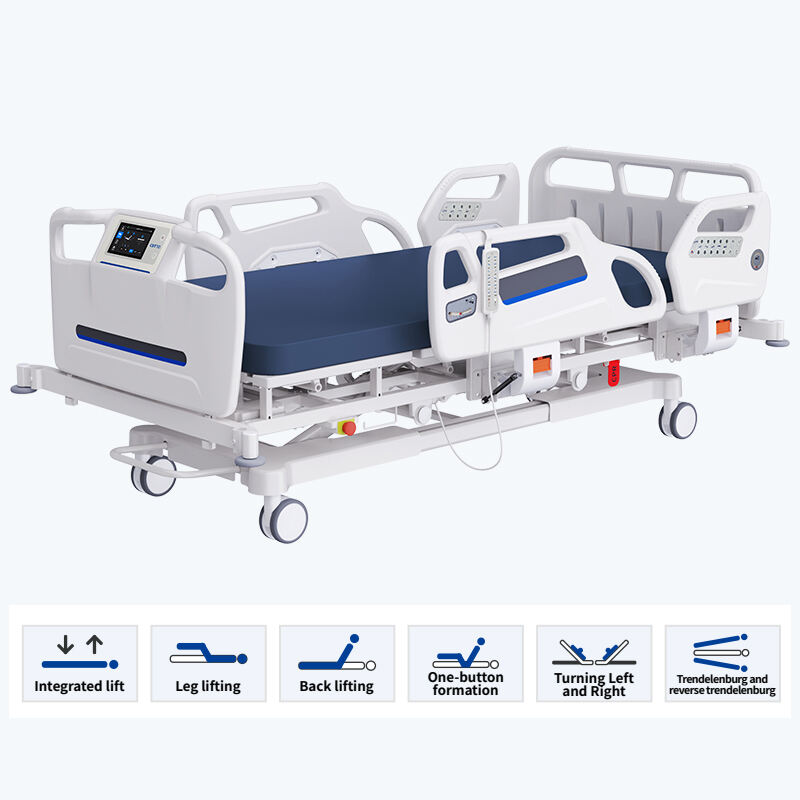Unit 301 No. 6 Xianghong Road,Torch Hi-Tech Zone Industrial Park,Xiang'an District, Xiamen P.R.China +86-592-5233987 [email protected]
At 3 a.m., in the corridor of the inpatient department, Head Nurse Wang Min gently tapped the remote control. The back panel of the hospital bed slowly rose to a 45-degree Angle, and the bedside display screen synchronously updated the patient's position data. This action, which once required the collaboration of two people to complete, can now be precisely performed by a single person with the assistance of an intelligent hospital bed. In the current era of rapid development in medical technology, intelligent hospital beds integrating seven core functions are reshaping the nursing work model, allowing medical staff to be relieved from repetitive physical labor and return to the patient-centered essence of medical care.

This multi-functional hospital bed, known in the industry as the "nursing revolutionary", deeply integrates modules such as electric adjustment, vital sign monitoring, and intelligent infusion. Its electric drive system supports stepless posture adjustment from 0 to 75 degrees. Combined with the anti-fall bed sensor belt and pressure distribution monitoring, it not only ensures the patient's comfort but also reduces the risk of care. Clinical data shows that traditional hospital beds require 6 to 8 manual adjustments per day, while smart hospital beds achieve real-time interaction between the medical staff and the beds through Internet of Things technology, reducing the related operation volume by more than 80%.
In the oncology ward, the automatic weighing system of the 7-function nursing beds has solved the problem of weight monitoring for patients who have been bedridden for a long time. The traditional method requires the collaboration of multiple people to transport patients to a dedicated scale platform. Now, simply input instructions into the mattress sensor, and the data with an error of no more than 0.1kg will be immediately uploaded to the electronic medical record. What is even more highly praised by the nurses is the integrated infusion management system. The three-level highly memory electric infusion stand is linked with the intelligent pump to achieve automatic calibration of the infusion rate and abnormal alarm, reducing the frequency of ward rounds from every half an hour to once every two hours.
The scenario-based design of the electric nursing bed breaks the cold impression of traditional medical equipment. The detachable dining board, reading lamp, privacy curtain and other humanized configurations, combined with the voice interaction system, enable bedridden patients to independently fulfill multiple life needs. In the rehabilitation department, the zero-gravity mode of the adjustable medical bed combined with the antispasmodic position setting has helped 37% of postoperative patients enter the active rehabilitation stage earlier. This design concept of integrating treatment needs into daily care is promoting the development of nursing work towards prevention and continuity.
When technology empowerment meets humanistic care, the value of smart hospital beds goes far beyond the accumulation of functions. Pilot data from a tertiary hospital shows that the average daily walking distance of the nursing team has decreased by 42%, the incidence of occupational injuries has dropped by 65%, while the duration of direct care has increased by 30%. This transformation enables nurses to have more energy to focus on core tasks such as disease observation and health education. Just as the nurse using the smart hospital bed said, "When the device can 'remember' the preferences of each patient, we can leave more 'memories' for the patients' rehabilitation stories."
From manual to electric, from single to intelligent, the evolution history of medical equipment has always been in harmony with the upgrading of nursing concepts. When the 7-function hospital beds weave a safe, efficient and warm care network in the wards, this quiet "bedside revolution" is bringing nursing work back to its most genuine form - safeguarding lives with professionalism and comforting hearts with warmth.